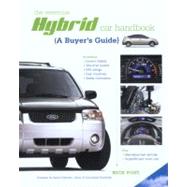
| Foreword | p. x |
| Introduction | p. 1 |
| Is a Hybrid Car for You? | p. 5 |
| Getting to Know a New Kind of Vehicle | p. 7 |
| Honda Insight: Got There First | p. 7 |
| What the Owners Say: Honda Insight | p. 10 |
| Toyota Prius: Also a First | p. 10 |
| What the Owners Say: Toyota Prius | p. 13 |
| A Good Try from the U.S. | p. 14 |
| Decision Factors | p. 15 |
| Hybrids Are Better for the Environment | p. 15 |
| Hybrids Are Here to Stay | p. 15 |
| Will You Save Enough on Gas to Justify the Price? | p. 16 |
| Other Cost Incentives | p. 19 |
| Do You Want to Make a Statement? | p. 22 |
| Evaluate the Downside | p. 24 |
| A Buyer's Guide to Hybrids | p. 27 |
| How Today's Hybrid Cars Work | p. 29 |
| The Four Types of Hybrid Powerplant | p. 30 |
| Driving Forces in the Hybrid Powerplant | p. 33 |
| Toyota | p. 38 |
| Toyota Prius | p. 40 |
| Toyota Highlander Hybrid | p. 44 |
| Toyota Camry Hybrid | p. 48 |
| Lexus RX 400h | p. 52 |
| Lexus GS 450h | p. 56 |
| Honda | p. 60 |
| 2006 Honda Insight | p. 62 |
| Honda Civic Hybrid | p. 66 |
| Honda Accord Hybrid | p. 70 |
| Ford | p. 74 |
| Mercury Mariner Hybrid/Ford Escape Hybrid | p. 76 |
| General Motors | p. 82 |
| Chevrolet Silverado Hybrid/GMC Sierra Hybrid | p. 84 |
| Saturn VUE Green Line Hybrid | p. 88 |
| Future Hybrids, Alternative-Fuel Vehicles, and Super-efficient Small Cars | p. 93 |
| Future Gasoline-Electric Hybrids | p. 95 |
| General Motors | p. 96 |
| Ford | p. 97 |
| Chrysler | p. 98 |
| Nissan | p. 98 |
| Toyota | p. 99 |
| Honda | p. 100 |
| Saab | p. 100 |
| Diesel Power-from the Europeans | p. 101 |
| Mercedes-Benz | p. 101 |
| BMW | p. 101 |
| Volkswagen | p. 103 |
| Audi | p. 103 |
| Porsche | p. 103 |
| Volvo | p. 104 |
| Manufacturers on the Fence | p. 104 |
| Hyundai and Kia | p. 104 |
| Subaru | p. 104 |
| Mini USA | p. 105 |
| The Plug-in Solution | p. 105 |
| How Plug-in Hybrids Work | p. 105 |
| Plug-ins on the Road | p. 108 |
| Alternative Fuels | p. 109 |
| Ethanol | p. 110 |
| Biodiesel | p. 112 |
| Hydrogen | p. 113 |
| Natural Gas | p. 116 |
| Electricity | p. 118 |
| Fuel-Sipping Minicars | p. 119 |
| Chevrolet Aveo | p. 120 |
| Dodge Caliber | p. 121 |
| Honda Fit | p. 122 |
| Hyundai Accent | p. 123 |
| Kia Rio | p. 124 |
| Nissan Versa | p. 125 |
| Suzuki Reno | p. 126 |
| Toyota Yaris | p. 127 |
| Super-efficiency | p. 130 |
| 100 Miles Per Gallon: Is That All? | p. 130 |
| 250 Miles Per Gallon? | p. 130 |
| 330 Miles Per Gallon? | p. 131 |
| 10,000 Miles Per Gallon? | p. 132 |
| Acknowledgments | p. 133 |
| Useful Web Sites | p. 135 |
| Photo Credits | p. 137 |
| Index | p. 139 |
| Table of Contents provided by Ingram. All Rights Reserved. |
The New copy of this book will include any supplemental materials advertised. Please check the title of the book to determine if it should include any access cards, study guides, lab manuals, CDs, etc.
The Used, Rental and eBook copies of this book are not guaranteed to include any supplemental materials. Typically, only the book itself is included. This is true even if the title states it includes any access cards, study guides, lab manuals, CDs, etc.
Excerpted from The Essential Hybrid Car Handbook by Nick Yost
All rights reserved by the original copyright owners. Excerpts are provided for display purposes only and may not be reproduced, reprinted or distributed without the written permission of the publisher.